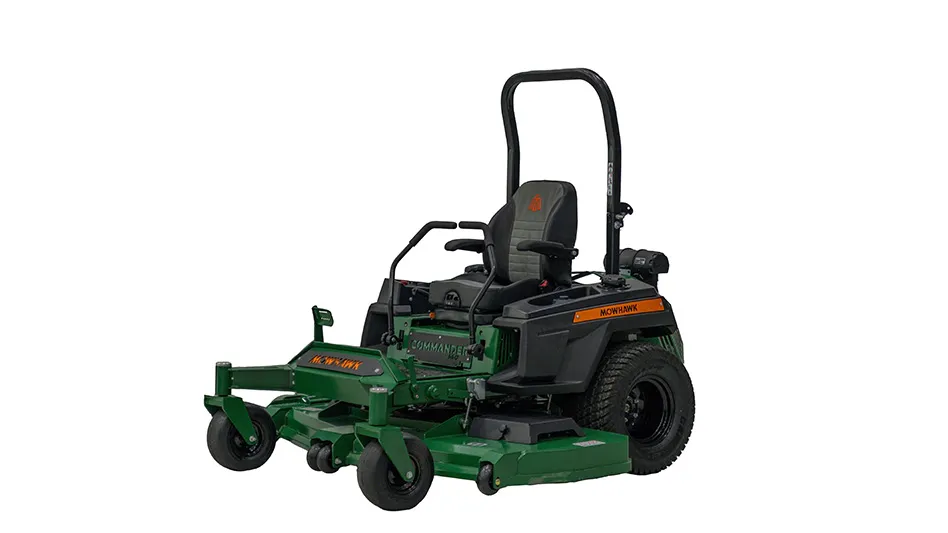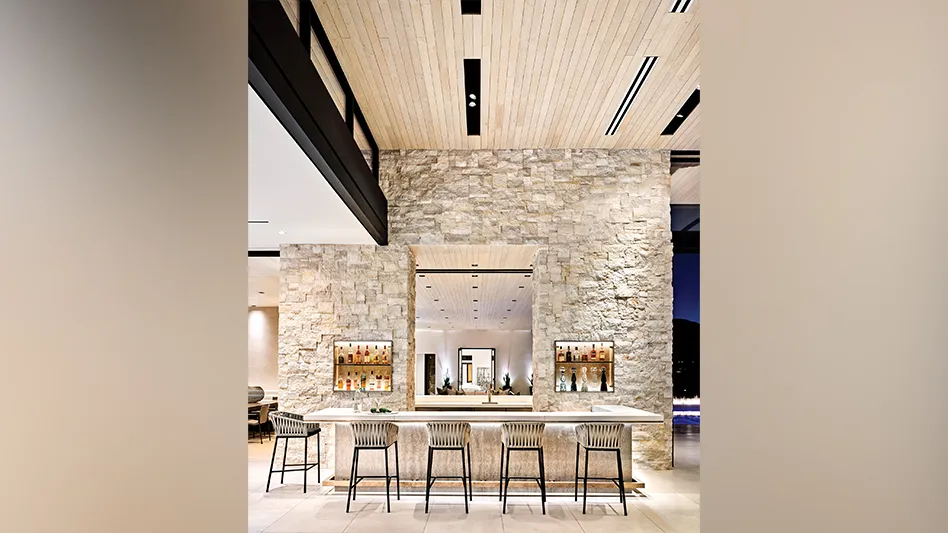Anthracnose, lethal yellow of palm, thousand canker – they aren’t warm and fuzzy names, and for good reason. Among their symptoms are dying flowers and branches and, worse case, death of an entire tree.
And those are just three of the diseases that could be growing on customers’ trees and shrubs.
So we asked The Davey Institute’s Deborah D. Miller, plant pathologist and senior diagnostician, and Grant Jones, technical adviser, to break down the 10 most common tree and shrubs diseases to look our for. Here is how the diseases are caused, how to identify symptoms and, most importantly, how to control and treat them. Of course, be sure to read and follow labels, as not all of the products are registered in every state.
Before looking at each in detail, here are the top 10 tree diseases:
- Anthracnose
- Apple scab
- Cedar rusts
- Diplodia tip blight
- Dothistroma needle blight of pines
- Lethal yellow of palm
- Oak Wilt
- Powdery mildew
- Photinia Leaf Spot
- Thousand canker disease
– Carolyn LaWell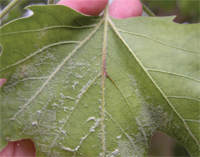 Anthracnose: Leonard F. Burkhart, Davey Institute Technical Advisor, Western and Pacific Northwest region;
Anthracnose: Leonard F. Burkhart, Davey Institute Technical Advisor, Western and Pacific Northwest region;
1. Anthracnose
Anthracnose is caused by a group of fungi that attacks leaves, twigs, flowers and fruits of a great number of tree and shrub diseases. It can be found throughout various species in most of North America, but important species to keep watch on are sycamore and flowering dogwood.
Anthracnose symptoms vary by the pathogen and host species. Sycamore anthracnose causes premature leaf defoliation and a twig blight resulting in witches blooming. Dogwood anthracnose is common on flowering dogwood in the Eastern U.S. and western flowering dogwood in the Pacific Northwest. All above-ground parts of the tree may be attacked, resulting in defoliation, branch dieback and tree death.
Control: For management of sycamore anthracnose, begin foliar applications of fungicides two weeks before bud break. Alternatively, trunk inject with a systemic fungicide. The most effective active ingredient is thiabendazole. In the case of dogwood anthracnose, foliar applications must begin at bud break and continue all through the growing season to protect the tree. For dogwood anthracnose, propiconazole is an effective fungicide. Good sanitation practices can also help reduce disease inoculum.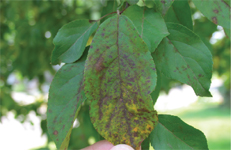 Apple scab: Joseph O’Brien, USDA Forest Service, Bugwood.org;
Apple scab: Joseph O’Brien, USDA Forest Service, Bugwood.org;
2. Apple scab
Apple scab is an early season leaf disease affecting crabapples. Some crabapple cultivars are more resistant than others. Scab-like lesions form on the leaves that eventually cause premature defoliation of infected trees.
Control: While mostly aesthetic, homeowners may find apple scab objectionable. It can be managed with fungicide applications with active ingredients, such as fenarimol, beginning at budbreak.
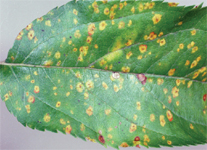 Cedar rusts: Clemson University - USDA Cooperative Extension Slide Series, Bugwood.org
Cedar rusts: Clemson University - USDA Cooperative Extension Slide Series, Bugwood.org3. Cedar rusts
Cedar rusts are common foliar diseases of rosaceous plants, such as hawthorn and crabapple. As with apple scab, some cultivars and species are more susceptible than others. Rust diseases require junipers as an alternate host. Orange or rust-colored leaf spots form on hawthorn and crabapples in the spring. Twig cankers can develop and cause dieback. Spore-producing structures form on the juniper branches.
Control: The disease can be managed with fungicide applications on the deciduous hosts beginning at budbreak or when orange spore masses develop on junipers. An active ingredient for controlling rust diseases is triadimefon. Prune out rust galls on junipers when noted.
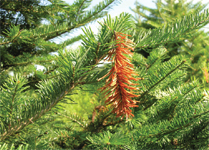 Diplodied: Ronald S. Kelley, Vermont Department of Forests, Parks and Recreation, Bugwood.org;
Diplodied: Ronald S. Kelley, Vermont Department of Forests, Parks and Recreation, Bugwood.org; 4. Diplodia tip blight
Diplodia is a common disease of Austrian and other pines. The disease initially develops at the base of the tree and progresses upwards. Candles and needles begin to expand before becoming infected and dying. Key symptoms include dead shoots with needles half elongated, lots of resin and witches brooms’ dead shoots. Black fruiting structures are present between needles and on cones.
Control: Management includes good sanitation, pruning and applying fungicides beginning at bud swell. An effective active ingredient for control is thiophanate-methyl.
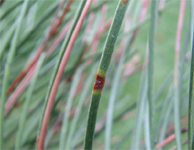 Dothistroma: Grant Jones, Midwest Technical Advisor, The Davey Institute;
Dothistroma: Grant Jones, Midwest Technical Advisor, The Davey Institute;5. Dothistroma needle blight of pines
Dothistroma needle blight is a fungal disease that causes a premature defoliation in mature trees and sever stunting and death of young trees. It can be found in more than 35 pine species and hybrids throughout North America. However, it is not found in the western Great Plains or central Rocky Mountains.
Symptoms of yellow or tan bands on needles are detected in the fall, followed by needle tip dieback. Austrian, lodgepole, Monterey and ponderosa pine are the most susceptible species in the United States.
Control:For management, begin applications of a protective fungicide at budbreak. Products with the active ingredient combination copper hydroxide and mancozeb are known to be most effective. Pruning out severely infected branches can also help in managing the disease.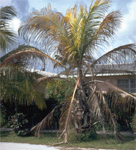 Lethal Yellow of Palm: USDA Forest Service - Region 8 - Southern Archive,USDA Forest Service, Bugwood.org;
Lethal Yellow of Palm: USDA Forest Service - Region 8 - Southern Archive,USDA Forest Service, Bugwood.org;
6. Lethal yellow of palm
Lethal yellowing is an important disease of palms in Florida and Texas. It is typically found in Canary Island date palm, coconut palm, date palm and other species, though native palms are usually not affected. Lethal yellowing is caused by a bacteria-like organism called a phytoplasma and is transmitted by a planthopper insect.
Symptoms vary with the host species. But generally flower death, premature fruit drop and foliage yellowing are distinctive symptoms. Infected palms usually die three to five months following infection.
Control: Preventative and therapeutic treatments with an antibiotic injected into the trunk can help manage the disease. An effective active ingredient is oxytetracycline hydrochloride. Removal of moderately infected plants and use of resistance species is also recommended. Insecticides for control of vectors have proven ineffective in managing disease spread.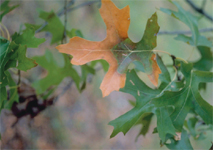 Oak Wilt: Paul A. Mistretta, USDA Forest Service, Bugwood.org
Oak Wilt: Paul A. Mistretta, USDA Forest Service, Bugwood.org
7. Oak Wilt
Oak wilt is a systemic fungal disease that results in tree death. The disease can be found in more than 20 oak species in Minnesota, Pennsylvania, South Carolina, Texas and recently New York. The disease is transmitted by infected beetles and through root grafts.
Initial symptoms on white and red oak are leaf wilt, rapid discoloration and premature defoliation. On live oak, the veins turn yellow then brown before defoliation occurs. A diagnostic feature is vascular discoloration.
Control: Trees in the white oak family can be treated therapeutically. Trees in the red oak family cannot. For prevention, inject trees with a systemic fungicide, such as propiconazole, during the growing season.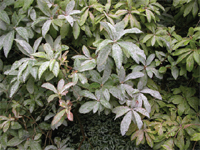 Powdery mildew: Leonard F. Burkhart, Western Technical Advisor, The Davey Institute;
Powdery mildew: Leonard F. Burkhart, Western Technical Advisor, The Davey Institute;
8. Powdery mildew
Powdery mildew is caused by a number of fungal pathogens that grow superficially on the plant surface producing white mycelia (fungal threads) and spores. It can be found in a host of trees throughout North America.
Leaf, flower and shoot distortion and stunting occur when the fungus attacks young tissue. As the level of infection increases, tissue becomes dried and brown. Premature defoliation may also occur. On susceptible rose varieties, flower production may be inhibited.
Control: For management, select resistant varieties, avoid planting in shaded areas and over-crowding and practice good sanitation. Begin fungicide applications when symptoms are first noted. An effective active ingredient for control is triadimefon.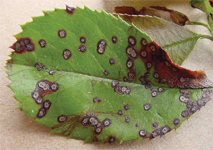 Photinia Leaf Spot: Paul Bachi, University of Kentucky Research and Education Center, Bugwood.org;
Photinia Leaf Spot: Paul Bachi, University of Kentucky Research and Education Center, Bugwood.org;
9. Photinia Leaf Spot
Photinia leaf spot is mainly found in the South and is an important defoliator of red tip photinia, Indian hawthorn, loquat and some pear cultivars. Infections by the fungal pathogen begin as small circular, dark red spots on leaves, stems and fruit. Spots coalesce into large blotches with gray centers.
Control: Management strategies include purchasing disease-free plants, sanitation, planting in sunny areas and fungicide applications. Begin treatment at budbreak and repeat applications until most of the leaves have matured. For very susceptible species such as photinia, additional fungicide applications may be necessary for good control. Applications of products with the active ingredient propiconazole are the most effective. Planting resistant varieties and species can also help with control.
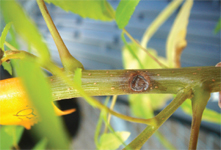 Thousand canker disease: Curtis Utley, CSUE, Bugwood.org
Thousand canker disease: Curtis Utley, CSUE, Bugwood.org10. Thousand canker disease
Thousand canker disease affects walnuts (Juglans sp.). It’s mainly found in the Western United States; although, black walnuts in Tennessee were found to be infected last summer.
It is vectored by walnut twig beetles and forms small cankers around their galleries. Over time these small cankers coalesce to girdle branches and stems. Trees can be infested for years before showing symptoms. Foliage in the upper branches of declining trees wilt and become yellow.
Control: Once a tree begins to decline, it is often dead within several years. At present there are no chemical management options for control.
Thousand canker disease: Curtis Utley, CSUE, Bugwood.org

Explore the April 2011 Issue
Check out more from this issue and find you next story to read.

